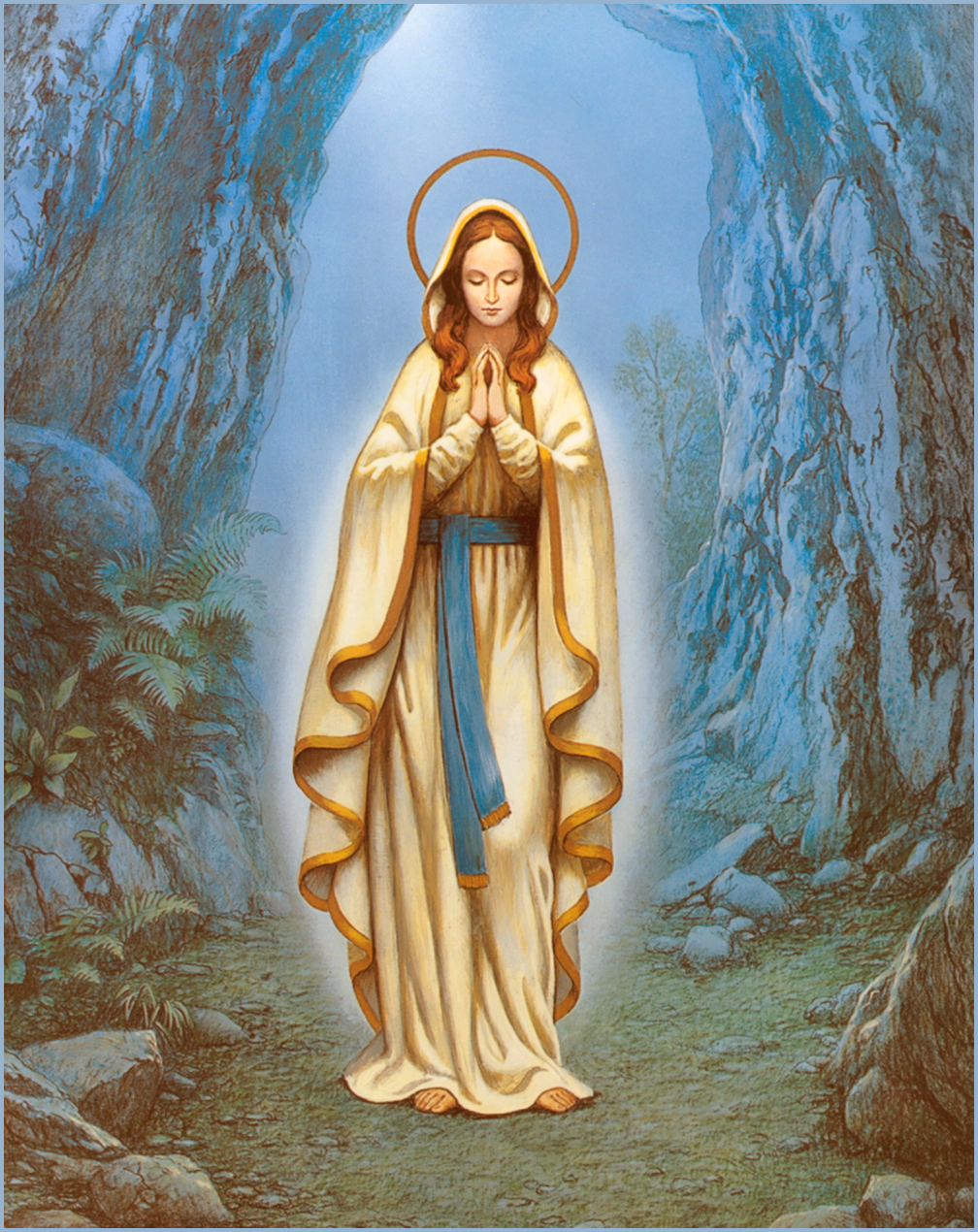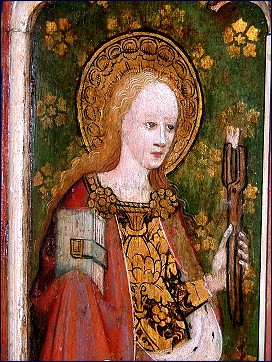
I am the Immaculate Conception . . .
IT IS MORE THAN 150 years since the birth of Bernadette Soubirous, the peasant girl whose visions led to the founding of the shrine at Lourdes in the foothills of the French Pyrenees. Nowadays four illuminated basilicas dominate the landscape, there are torchlight processions every day, and the shops are full of statuettes and relics. Five million pilgrims or religious tourists visit every year.
At the time of her vision Bernadette was fourteen years old and barely literate, and had to look after her younger brothers while her mother went out cleaning. On February 11, 1858, while Bernadette was out collecting wood with her sister Toinette and her friend Jeanne, they came to a place where the millstream joined the shallow river by a grotto at Massabielle. The other girls waded through the water, crying because it made their feet so cold. As Bernadette, a sickly, asthmatic girl, held back, she heard what she described as a roar. Later she reported: "I raised my head and looked towards the grotto. I saw a Lady dressed in white, wearing a white dress, a blue girdle and a yellow rose on each foot, the same color as the chain of her Rosary: the beads of her Rosary were white."
The vision was praying the Rosary. Bernadette took out her beads and did the same. The Lady beckoned but, when the girl dared not approach, she vanished. Toinette and Jeanne saw nothing and at first Bernadette did not tell them what she had seen but they got the story out of her and told her parents. The Soubirous family would not allow her to visit the grotto again, but the girl told her priest, Father Pomian, about the vision and he discussed it with the parish priest of Lourdes, Father Peyramale.
A VISION CALLED AQUERO
On February 14, a Sunday, Madame Soubirous relented. Bernadette took a bottle of holy water to the grotto and knelt down to say her Rosary. The Lady appeared again. Bernadette said, "I started throwing holy water at her and told her that if she came from God to stay, and if not to go." The vision smiled and bowed her head and as Bernadette was frightened, Our Lady disappeared. On the 18th Bernadette returned once more, this time with two adults, Madame Millat and Antoinette Peyret, "who advised me to take paper and ink and to ask her, if she had anything to say to me, to be so good as to write it down." The Lady appeared, said that what she had to say need not be written down, and asked Bernadette if she would come each day for a fortnight. Bernadette began to refer to the vision as Aquero, which means simply, 'It', and said that the Lady spoke in the Lourdes dialect, 'sweet and gentle', and not in French. On this third visit Aquero said, "I do not promise to make you happy in this world, but in the other."
According to Bernadette, between February 19 and March 4 "The vision appeared every day except one Monday and one Friday. She told me several times that I should tell the priests that a chapel should be built there and . . . I should pray for the conversion of sinners. She gave me three secrets which she forbade me to tell anyone."
Bernadette's account caused mixed reactions. The local police inspector interrogated her and tried to muddle her testimony, but could not: his notes of the interview have been preserved.
Some of the villagers were angry at him and threatened to break down the door if he would not release the girl.
Our Lady told Bernadette to drink from the spring-----a little muddy water that appeared from beneath the rock. Bernadette said, "I threw it away three times because it was so dirty, but the fourth time I was able to drink it . . .
The Public Prosecutor, Dutour, tried to rig Bernadette's account, but again local men hammered on his door and, trembling, he let the girl and her mother go. Later Bernadette said, "There was something in me that enabled me to rise above everything. I was tackled from all sides, but nothing mattered and I was not afraid."
I AM THE IMMACULATE CONCEPTION
At five o'clock on the morning of March 25, the Feast of the Annunciation of the Virgin Mary, Bernadette felt compelled to go again to the grotto. The Lady was already there. "With her two arms hanging down, she raised her eyes and looked up at the sky, and it was then that she told me, joining her hands together now at the height of her breast, that she was the Immaculate Conception. Those were the last words she ever said to me." Four years before these events, Pope Pius IX had proclaimed the dogma of the Immaculate Conception. For centuries this doctrine-----that the Virgin Mary had been conceived and born without the taint of Original Sin-----had been a pious belief among the ordinary people; but the proclamation of 1854 had made it part of the Church's official teaching.
Controversy surrounded the event, and it is possible that Bernadette had heard angry words flying about in a devout village. But Father Peyramale was convinced by Bernadette's story and became her strongest supporter.
On June 3, the Feast of Corpus Christ, Bernadette made her First Communion. By the 16th, when Bernadette returned to the grotto, fences had been put up around it and she was obliged to say her Rosary from a distance. When questioned she said, "I saw nothing but the Blessed Virgin."
In 1862 a series of interrogations by bishops began. They were impressed by 'her simplicity, candor and modesty, the wisdom of her answers, her calm imagination and commonsense above her age'. To skeptics Bernadette replied, "I have been told to tell you about it. I have not been told to make you believe it."
THE VISIONS AUTHENTICATED
Lourdes quickly became a popular shrine and visitors tried to shower Bernadette with money, to steal a relic from her or to cut off a piece of her hood or her dress as a souvenir. She complained of the adulation and said it tired her. Hundreds of letters were addressed to her; she prayed for their senders and asked them to pray for her in turn.
In 1862 the Bishop of Tarbes authenticated the visions and the hard-pressed Bernadette applied to join the St. Bernard nuns at Anglet, but was turned down because they did not want to be over-run by pilgrims and tourists. Four things told against her vocation: poverty, fame, poor education and lifelong bad health. In March 1862 Bernadette became very ill and she was given the Last Rites. She recovered to nurse old people in the hospice at Lourdes.
In April 1866 she succeeded in becoming a postulant at Nevers. On her first day she was ordered to recount her visions to the whole community and then never speak of them again. "I have come here to hide," she declared. She carried with her three small stones of which she said, "These are my companions whom I love." On them she had written the words 'Lourdes', 'The Grotto' and 'Nevers Mother House'. In July she received the habit and became known as Sister Marie-Bernard, but in October she was so ill that she was again given the Last Rites. Once more she defied death, and was later put in charge of the hospital.
In June of 1873 she was given the Last Rites for the third time. Yet again she recovered and this time was appointed Assistant Sacristan-----the person who kept the chapel clean and in order. But from April of 1875 she was a complete invalid, and on April 16, 1879 she died at three in the afternoon-----the same hour as Christ's death on the Cross.
THE SUFFERINGS OF BERNADETTE
What, apart from this bare chronology, can we know about Bernadette Soubirous? One thing is certain: she strove with all her might to fulfill the vocation announced to her by the Virgin at Massabielle-----to do penance, to pray and suffer for sinners. And she did suffer. The Mother Superior at Nevers testified, "It took her an hour to find a bearable position, during which her face changed and she became as if dead. Even when asleep, the faintest movement of her leg made her cry out. Such sharp cries that her companions in the dormitory could not sleep. She shrank to nothing." In fact, she had tuberculosis. Bernadette did not 'enjoy' suffering, though she spoke of it as 'my job'. And she once said, "I pray to St. Bernard, but I do not imitate him. St. Bernard liked suffering, but I avoid it if I can."
Apart from her physical pain, she bore much personal grief. Her mother died early, at forty-one. Her sister Toinette's first child, also named Bernadette, died in February of 1871, to be followed by her father a month later. In fact all five of Toinette's babies died and Bernadette wrote to her: "I like to imagine that dear little group praying in Heaven for us poor exiles on this miserable earth."
Bernadette suffered, too, from the interrogations of religious historians who tried to make her offer elaborate theological explanations for her visions. But she replied, "It is best for people to speak and write very simply. It is more moving to read the Passion than to have it explained."
In the last stages of her final illness, she requested to be left only with the crucifix sent to her by Pope Pius IX. When she became too weak to hold it, she had it fastened to her breast. After her death she was first beatified in 1925 and then canonized as St. Bernadette in 1933. Her Feast Day is February 18.
Is there anything truer or more beautiful, anything more desperately needed in our own violent times, than the heartfelt desire to pray for the forgiveness and salvation of others as well as for ourselves, and to follow the intuitive, undefeated sense and hope in all of us that love and tenderness are the immaculate things in a sullied world? It is not out of place to describe this longing as a vision of the Mother of God.
THE BEAUTY AND WORK OF LOURDES TODAY
Lourdes is justly regarded as the most important place of Catholic pilgrimage in the world after the Holy Land and Rome. It comprises four magnificent basilicas and the grotto marking the exact spot where Our Lady appeared to Bernadette.
It is an awe-inspiring and unforgettable experience for the pilgrim or visitor to join one of the torchlight processions which begin at the grotto and lead to Rosary Square where the sick are blessed in the name of the Holy Mother. Traditionally there are four gifts of Lourdes: the gift of miraculous water, the gift of healing, the gift of reconciliation, the gift of strength and friendship.
In 1866 the first Mass was offered at the grotto, and on the Feast of the Assumption in 1871 the newly built Church of the Immaculate Conception was blessed. The following year saw the first national pilgrimage, with flags and banners and a torchlight procession. In 1873 the Assumption Fathers organized a much larger pilgrimage and a year later the first visitors came from abroad, particularly from Belgium and the USA. The statue of Our Lady of Lourdes was crowned in 1876 and the second of four great basilicas-----the Church of the Rosary-----was opened in 1889. On March 25, 1958, the centenary of the apparitions, the Basilica of St. Pius X was consecrated.
There have been five thousand cures which have taken place. Sixty-five of these cures have been officially designated 'miraculous' by the Church. Wonderfully moving is the nightly procession of the Holy Rosary.














